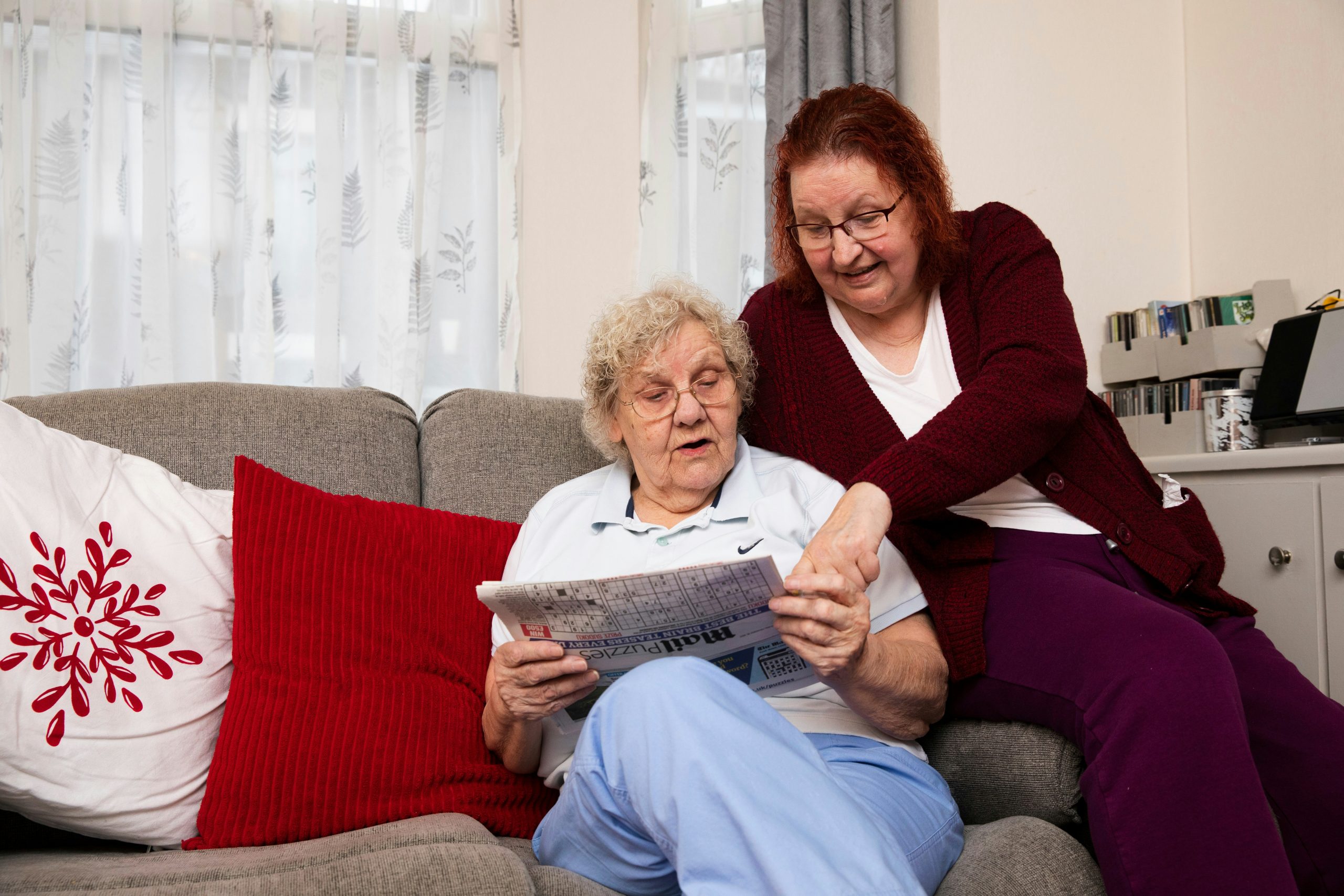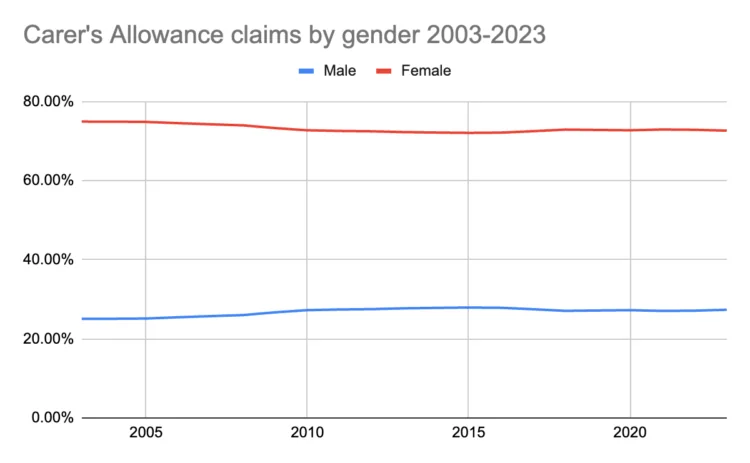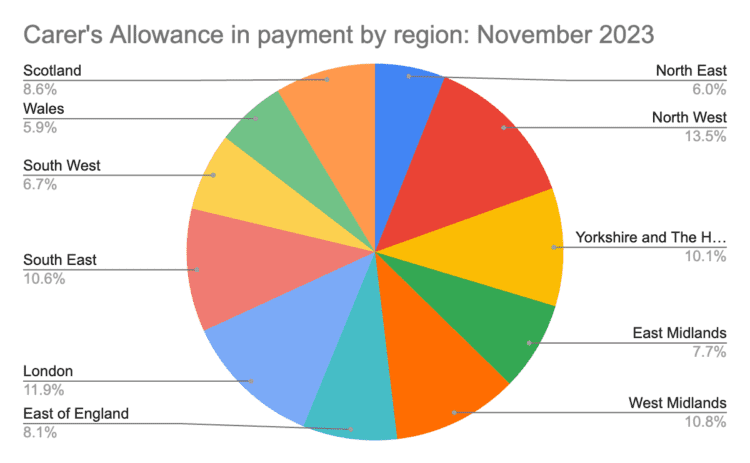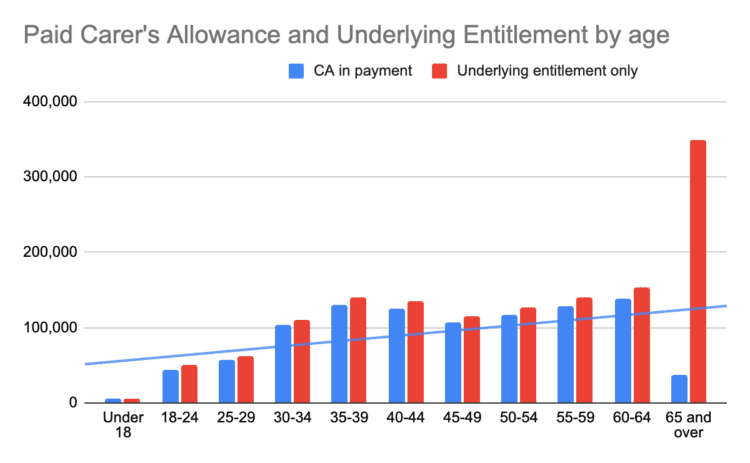Carer’s Allowance: We can, and should, care more about carers

More than 500,000 carers are missing out on at least £2.3 billion a year in unclaimed Carer’s Allowance. Meanwhile, unpaid carers save the British economy around £162 billion a year, a figure close to the yearly cost of delivering the whole of the NHS for England and Wales.
But this is economic value only, and to reduce the impact carers make to a pound figure grossly and unfairly undervalues the role carers play in upholding our wider care system.
And yet the system of financial support we have currently in the UK does place a pound value on unpaid care; an amount that is falling far short of what is needed to ensure we care enough about carers.
As we celebrate National Carers Week, this blog explores the complexity of Carer’s Allowance, the people who claim it, the rise of media reports of carers falling foul of a rigid and unforgiving system, and what we could do to support carers and the people they care for.
Care is valued at £2.34 an hour, 132% lower than the national living wage
It’s fair to say that Carer’s Allowance is not a generous benefit. To qualify, someone must provide at least 35 hours a week of unpaid care, the equivalent of a full time job. The carer must also earn less than £151 per week from any earned income in addition to their caring responsibilities.
Add to the mix a handful of other eligibility criteria such as the cared for person’s own benefit claims, and an unpaid carer could be awarded £81.90 per week. £81.90 per week is £2.34 an hour.
To give this some context, the national living wage for someone over the age of 21 is £11.44 per hour. This is 132% higher than the hourly rate at which we currently value unpaid care.
The low value of Carer’s Allowance and the multi-layered eligibility criteria is already off putting to claimants, but the complexity does not end there. Nor does the devaluation of unpaid care.
Once claimed, Carer’s Allowance can be offset against other benefit income, reducing state support for both the carer and the cared for person. The list of pitfalls does not make for optimistic reading:
-
Claiming Carer’s Allowance means the cared for person will stop receiving Severe Disability Premiums worth £81.50 per week for a single person
-
The cared for person, if claiming, will lose their entitlement to additional amounts of severe disability payments in Pension Credit, worth £81.50 per week for a single person
-
For the unpaid carer, the equivalent amount of Carer’s Allowance will be deducted from a Universal Credit claim in payment
-
If an unpaid carer receives a state pension equivalent to, or more than, the rate for Carer’s Allowance, they will not receive a payment of Carer’s Allowance
-
If someone is claiming a state pension at a lower rate than Carer’s Allowance, they may only claim the equivalent of up to the Carer’s Allowance limit. So, someone claiming £50 per week state pension can only claim £31.90 per week in Carer’s Allowance
-
Carer’s Allowance is not increased if someone provides care for more than one person. Payments remain at a limit of £81.90 per week
-
If a carer earns more than £151 per week, even by a few pence, they lose their full Carer’s Allowance payment
73% of Carer’s Allowance claimants are female
The most recent figures available from the DWP tell us 991,000 unpaid carers currently receive Carer’s Allowance. Crucially, a further 1.4 million carers are recorded as having ‘underlying entitlement’ to Carer’s Allowance but receive no payment as a result of the many offsets and deductions in other areas.
The breakdown of claimant demographics for Carer’s Allowance provides a window into who is providing unpaid care, and who is therefore more likely to fall foul of the system.
73% of Carer’s Allowance claimants are female. Proving unpaid care has long been a gendered divide of labour, and for unpaid carers in receipt of Carer’s Allowance, this gendered split is unchanged over the last 20 years.

Carer’s Allowance payments by male/female binary gender from November 2003 to November 2023. Source: DWP StatXplore
30% of Carer’s Allowance claimants live in the North of England. Poorer health, lower wages, and regional strains on local government services may be bringing more people into Carer’s Allowance entitlement in the north. Around 27% of Carer’s Allowance claimants live in the Midlands, and 29% live in London or the South. Proportionally low claim rates in Scotland and Wales are due on the whole to lower proportions of the population.

Carer’s Allowance in payment by region, November 2023. Source: DWP StatXplore
Claims for Carer’s Allowance increase with age, with 42% of all Carer’s Allowance paid to people over the age of 50. But it is pension age claimants who are missing out the most as a result of falling into underlying entitlement, but receiving no additional support payment to compensate or contribute to the costs of providing unpaid care.

Unpaid carers owe more than £250 million in overpaid Carer’s Allowance
Given the systemic complexity of Carer’s Allowance and its interactions with other benefits, rigid earnings thresholds, and known additional vulnerability created by being an unpaid carer, it may be surprising that for the most part, it is the responsibility of the unpaid carer to inform various agencies that they receive Carer’s Allowance. It is also the responsibility of the carer to keep an eye on their earned income, with potentially dire consequences for failing to do so.
Recent reports found that the DWP is currently managing more than £250 million in overpaid Carer’s Allowance from more than 134,000 unpaid carers whose earnings have breached the £151 per week threshold. In one such case, an unpaid carer was given a suspended prison sentence and required to wear an electronic tag.
The rise of news stories on overpaid Carer’s Allowance is welcomed. Reports that the harm caused by the rigidity of the earnings threshold and the creation of overpayments highlight a crucial wrong the system needs to right. But are these reports fuelling more fear around the complexity of Carer’s Allowance and will we see more people not claiming as a result? Only time will tell.
Hopefully, the system will change in response to repeated calls for reform before the fear of overpayments can further impact the meagre levels of financial support provided. And with continued pressure through media reports and calls from organisations such as the Carers Trust, Carers UK, and the 130 organisations of the Carer Poverty Alliance, reforming Carer’s Allowance should be high on the agenda for a new government.
In the meantime, the National Audit Office is set to conduct an investigation into Carer’s Allowance and the DWP has stated they will investigate changes to Carer’s Allowance including potential earning tapers to prevent cliff edges and text message alerts to notify claimants when their earnings have reached the Carer’s Allowance limit.
Additionally, planned reforms to Personal Independence Payments are set to include the impact on Carer’s Allowance, a nod to the connected complexity between different benefits.
Smarter use of data is key to supporting unpaid carers
Changes to Carer’s Allowance are needed desperately. Not only for carers falling foul of a rigid and complex system but also so that people can continue to receive care from their friends and family. Being an unpaid carer should not come with financial penalties and additional complexity.
Real-time earnings data is used in Universal Credit to adjust payments during each monthly assessment period. This aims to prevent overpayments and reduce the burden of repeated self-reported earnings for both the state and the claimant. A similar use of earned income data should be implemented for Carer’s Allowance, as a minimum.
Communicating that someone may have underlying entitlement or increased vulnerability as a result of being an unpaid carer will reduce stigma and complexity when dealing with multiple agencies. The Vulnerability Registration Service is doing just that.
Introducing a flag for unpaid carers will mean other financial services such as lenders and creditors will be made aware of unpaid carers and be able to accommodate their circumstances when possible. This is a great leap towards providing greater dignity and consideration to unpaid carers.
Three unpaid carers supported out of temporary accommodation
Policy in Practice works with local authorities to identify unpaid carers and increase awareness and entitlement to financial assistance. One recent campaign by a London authority supported 11 unpaid carers, which may not seem like many, but the difference made cannot be understated, not least to the families involved.
Three unpaid carers moved out of temporary accommodation, saving the local authority around £16,000 per household per year. Financial savings aside, any household moving out of temporary accommodation is a victory for any local authority and, with more than £1.7 billion a year spent on temporary housing, every little helps.
The benefits of the Carer’s Allowance campaign did not stop there:
-
Income after costs across all unpaid carers increased by £185 a week on average
-
Additional benefits for unpaid carers were increased by an average of £58 per week
-
Ten fewer households were in a cash shortfall as a result of the council’s work with the Low Income Family Tracker (LIFT)
-
All 11 households were lifted out of relative poverty
-
Ten households saw their debts reduce by more than £6,3000, including debt to the council such as Council Tax
To find out more about how your council can help care for unpaid carers talk to Policy in Practice.




